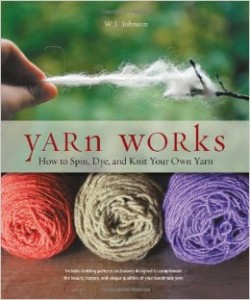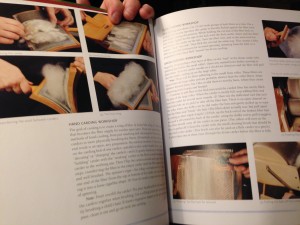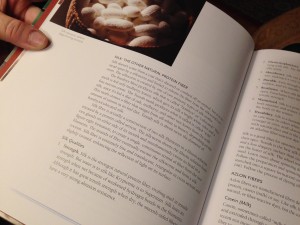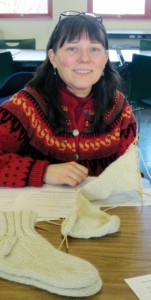
It’s been difficult to write, because I love this book so much, and each time I sat down to review it I felt I couldn’t do it justice.
I finally realized that, short of reprinting entire chapters of the book here on my blog, nothing could really reflect how helpful Yarn Works is until one actually reads it.
This is a unique and incredibly useful book. It is textbook-like in it’s scholarship, it’s appendices and illustrations. But, unlike the average textbook, Yarn Works is a delight to read.
Yarn Works is broken into 4 sections; Fiber Workshop, Spin Workshop, Dye Workshop and Knit Workshop. Each section is clearly divided into chapters which take the reader through each topic, step by step, with very clear and understandable instructions.
I don’t know what Wendy’s middle name is, but it could easily be “Clarity.”
I must confess that when I review a book, I usually don’t read it cover to cover. If it’s a pattern book I’ll peruse the garments, pick a few and read through the pattern to see if I can understand the writing style. If it’s a technique book I’ll try a few of them out, also to see if the writing style resonates with me.
In this case, I’ve been taking this book to bed with me and scanning it (heck, I took it to DC with me and read it in hotel rooms along the way…) and I’m in love with it.

Now I dye yarn, too, which takes up the lion’s share of my days, so I was most intrigued to read Wendy’s take on these aspects of my ‘life’ – dyeing and knitting.
I must admit that I didn’t spend a great deal of time on the Spin Workshop. I read the section, as I did the Fiber Workshop section, and found the information clear and concise. I’m not a spinner; my asthma makes it difficult for me to even knit with very soft fibers (like alpaca or angora), forget about spinning fiber!

I’ve spent the past week doing some hard-core dying, finishing up many kilograms of yarn for various clubs and shows, and I’ve felt gratified by how words from Yarn Works come to me at various parts of the process.
Through trial and error over the past year, as ModeKnit Yarn has been moving up to speed, I’ve come to many of the same conclusions that Wendy comes to in her book. However, I didn’t understand the science or theory behind many of my discoveries, and reading about them has been incredibly helpful.

I love Wendy’s embracing attitude that there are MANY right and good ways to create and dye fiber — as many as there are dyers — but the science behind dyeing doesn’t change from dyer to dyer.
If you have an interest in spinning, dyeing or knitting, want to understand the basics of different fiber types and what differentiates different protein fibers (or how cellulose seed fibers differ from cellulose bast fibers) and want to learn all of this in a friendly and comfortable environment, Yarn Works is the book for you.

Yarn Works
W. J. Johnson
ISBN: 978-1-58923-788-9
Creative Publishing Int’l

